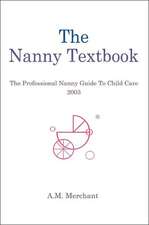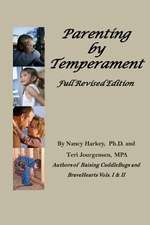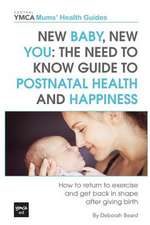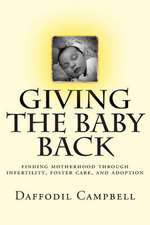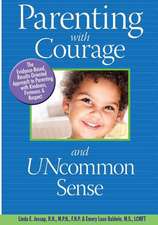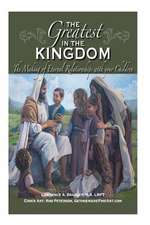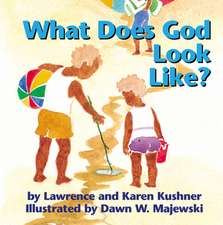How to Raise a Jewish Child: A Practical Handbook for Family Life
Autor Anita Diamant Karen Kushneren Limba Engleză Paperback – 31 iul 2008
Preț: 122.04 lei
Nou
Puncte Express: 183
Preț estimativ în valută:
23.35€ • 24.51$ • 19.38£
23.35€ • 24.51$ • 19.38£
Carte disponibilă
Livrare economică 20 martie-03 aprilie
Preluare comenzi: 021 569.72.76
Specificații
ISBN-13: 9780805212211
ISBN-10: 0805212213
Pagini: 291
Dimensiuni: 137 x 204 x 19 mm
Greutate: 0.24 kg
Ediția:Revised, Update
Editura: SCHOCKEN BOOKS INC
ISBN-10: 0805212213
Pagini: 291
Dimensiuni: 137 x 204 x 19 mm
Greutate: 0.24 kg
Ediția:Revised, Update
Editura: SCHOCKEN BOOKS INC
Notă biografică
Anita Diamant is the author of six books about Jewish life, including The New Jewish Wedding, Living a Jewish Life, and Saying Kaddish. She is also the author of three novels, including The Red Tent. She lives in Newton, Massachusetts.
Karen Kushner is the director of Project Welcome, a San Francisco outreach initiative welcoming interfaith families, unaffiliated Jews, and spiritual seekers into synagogues. The co-author of four children's books, including Because Nothing Looks Like God, she lives in San Francisco.
Karen Kushner is the director of Project Welcome, a San Francisco outreach initiative welcoming interfaith families, unaffiliated Jews, and spiritual seekers into synagogues. The co-author of four children's books, including Because Nothing Looks Like God, she lives in San Francisco.
Extras
From Chapter 1
Values
and Goals
Jewish parents celebrate the birth of children with delight, with food, and with an ancient promise called brit--covenant. Brit is the way Jews conceive of their relationship with God: it is a contract renewed in every generation when parents gather family, friends, and community to say, "This child is now part of the Jewish people."
This covenant is "sealed" with rituals and celebrations (explained in Chapter 6). But the ceremonies are only the beginning of this "bargain." At virtually every brit milah (covenant of circumcision) or brit bat (covenant for a daughter), parents and friends recite a prayerwishpromise that constitutes the "fine print" of the brit:
As heshe has been brought into the covenant, so may heshe enter into Torah, huppah [the wedding canopy] and ma'asim tovim [good deeds].
This ancient three-fold wish gives voice to the dreams and hopes of Jewish parents. Generations understand and interpret these terms differently, but the fundamental principles transcend history, because they express universal wishes that children reach their full potential--intellectually, emotionally, morally, and spiritually.
Torah, huppah, ma'asim tovim. Each of these ideas is both metaphor and goal, each implies traditional values and demands authentic standards. And though they may seem like nouns, they are really imperative verbs. Torah means "Learn." Huppah means "Love." Ma'asim tovim means "Live righteously."
These principles are not abstractions, because each of them is a mitzvah. Mitzvah is the Hebrew word for "commandment" or "good deed," or "Jewish obligation." There really is no English term that captures the complexity of this concept. Mitzvah is simultaneously value and goal, concept and action. Mitzvah is praxis--it is how you "do" Judaism, which is an activist tradition, passionately concerned with the details of how life should be lived. Matters of faith are, by comparison, left unspoken, which is why it's no accident that the three-fold prayer for babies does not mention God.
Of course, for many Jews, "commandments" imply a divine Commander, which means that mitzvot (the plural of mitzvah), laid out in the revealed scripture, called Torah, must be obeyed. But there are other ways to understand mitzvot and to feel commanded or directed by Jewish tradition.
The Hasidic teacher Rabbi Yehuda Aryeh-Lieb of Ger discerned a relationship between the Hebrew mitzvah and an Aramaic word that means "together," and taught that a mitzvah could be seen as an act that unites people, and connects people with the divine.2 Thus, teaching and modeling mitzvot to your children becomes a way to unite them with the Jewish people throughout history and around the world, and also to unite their lives with such sacred purposes as shalom (peace) and tzedek (justice).
Merle Feld, a contemporary Jewish feminist, recasts the word in a different light. "I can't honestly say we are 'commanded' to rest--it's not my language--I don't think I've ever felt 'commanded' to observe Shabbat or anything else for that matter. 'Invited' feels like a more accurate verb for me."
Being a Jewish parent means forging your own understanding of and connection to these mitzvot, and then teaching and showing your children how to learn, love, and do good--as Jews.
Torah
Torah is a complicated word. "The Torah" refers to the first five books of the Hebrew Bible*, also called the Pentateuch, or the Five Books of Moses.
* The word for "Bible" comes from the Greek biblia, meaning "books." The Hebrew Bible includes the Five Books of Moses, the Prophets, and the Writings. This is what Christians call the "Old Testament," believing that Jesus announced a new covenant between God and humanity, which was spelled out in a "New Testament."
"A Torah" is the handwritten scroll from which Jews read in an annual cycle of Genesis, Exodus, Leviticus, Numbers, and Deuteronomy.
"Torah" means "teaching," and can refer to much more than the Five Books of Moses. It may be applied to the entire Bible--as well as to Jewish commentaries, starting with the Talmud and embracing contemporary theology.
Finally, since every person is unique and every person has something to contribute to the on-going conversation about Jewish texts and Jewish life, everyone can be said to be in possession of his or her own "Torah."The Talmud, the great collection of Jewish thought compiled between 200 b.c.e. and 500 c.e, places Torah study at the apex of all human endeavor: These are the obligations without measure, whose reward, too, is without measure: To honor mother and father, to perform acts of lovingkindness, to attend the house of study daily, to welcome the stranger, to visit the sick, to rejoice with the bride and bridegroom, to comfort the bereaved, to pray with sincerity, to make peace when there is strife. And the study of Torah is equal to them all.
Torah study is considered a delight and one of life's great pleasures, yet it is not entirely its own reward. As the Talmud points out, it is meant to lead to all forms of righteous behavior: offering hospitality, making peace where there is strife, participating in all of life's pleasures (weddings) and sorrows (funerals)--in other words, Torah study is the path to doing mitzvot.
A life of Torah may also be understood as an on-going engagement with others in a lively reading and re-reading of Jewish texts. Torah study is not accomplished through memorization and recitation, nor can it ever be "mastered," since Torah is an on-going, dynamic, and essentially creative process.
Nevertheless, the process of Jewish learning does yield intellectual rewards. The back-and-forth dialectic that is the essence of classical Torah study, encourages curiosity, diligence, intellectual precision. It rewards hard questions and honors new ideas. Students of Torah are expected to disagree with each other and even with their teachers--respectfully but forcefully.
Torah celebrates context--the warmth of community--as well as content--the light of insight. Or, in more traditional language:
It is a tree of life to those who hold fast to it
And all of its supporters are happy.
Teaching "Torah"
Universal literacy among Jews is a long-standing tradition. Even in times and places when reading and writing were the privilege of aristocracies and their minions, Jews taught their sons to read. The most sought-after groom was not a rich man but a promising scholar. And even though literacy was considered less important for women, fathers in every generation saw to it that their daughters learned to read, though often in a vernacular, such as Yiddish, rather than the sacred language of Hebrew.
The American Jewish community is famous for academic attainment. In any given year, 20 to 40 percent of students at Ivy League schools are Jewish, as are nearly 40 percent of America's recent Nobel laureates.7 But Jewish literacy is another matter. While most American Jews are familiar with the works of Shakespeare, the writings of Maimonides are known to a much smaller number. Only a minority can read Hebrew.
Jewish parents are becoming less tolerant of this discrepancy between general and Judaic knowledge and are working to provide their children with a solid understanding of Jewish concepts, languages, values, and texts.
No two Jews will agree on what belongs on a list of the fundamentals of Jewish literacy, but for the sake of a worthwhile argument, here is one attempt at an outline of the Jewish Basics that will guide you as you consider what you want your own child to learn:
oA Jewish Vocabulary English, Yiddish, and Hebrew terms that give the speaker a sense of membership and mastery of some basic Jewish concepts: synagogue, Israel, rabbi, cantor, chutzpah, kippah, mitzvah, schlep, shalom, Shema, Shabbat, Torah, tzedakah.
oFamiliarity with Jewish Holidays The annual cycle of major celebrations: Rosh Hashanah, Yom Kippur, Sukkot, Simchat Torah, Hanukkah, Purim, Passover, Shavuot. Also, Tu B'Shvat, Holocaust Remembrance Day, Israel Independence Day, Tisha B'Av.
oBiblical Characters and Bible Stories The stories we've been telling our children from the beginning: Adam and Eve, Noah and the Flood, Abraham and Sarah, Isaac and Rachel, Jacob and Leah and Rebecca, Joseph and his brothers, Moses, Aaron, Miriam and the Exodus, Ruth the convert, Isaiah the prophet.
oFamous Jews Names that are a source of identity and pride: the Baal Shem Tov, Bruria, Martin Buber, Albert Einstein, Anne Frank, Abraham Joshua Heschel, Emma Lazarus, Maimonides, Golda Meir, Rashi, Yitzhak and Leah Rabin, Jonas Salk, Henrietta Szold.
oJewish Geography Finding ourselves around the world: Jerusalem, Babylonia, Barcelona, Warsaw, Chelm, Borough Park, Tel Aviv.
oJewish History From Ancient Israel to the State of Israel, the 4,000-year saga includes the Golden Age in medieval Spain, the Holocaust, and the story of the Jews in America.
oModern Jewish Culture High and low: the stories of Sholom Aleichem and the humor of Mel Brooks, the klezmer stylings of Mickey Katz and the symphonies of Leonard Bernstein, the show tunes of George and Ira Gershwin and the pop tunes of Paul Simon, the fiction of Cynthia Ozick and Allegra Goodman.
oTeaching Tools Children's books are a great resource for teaching the "basics," and since the 1980s, there has been a renaissance in Jewish children's literature--from picture books to young-adult fare. Browsing in a Jewish bookstore or through a Jewish book catalogue, parents can encourage their kids' interests by saying yes when they are intrigued by a title or topic.
Ultimately, Jewish literacy requires some kind of formal Jewish education. Unfortunately, many adults recall Hebrew school as a miserable or irrelevant experience that may have even alienated them from Judaism and Jewish life. To instill a love of Torah--a lasting commitment to Jewish learning that can be a source of meaning and connection--means insisting on excellence in whatever Jewish educational institution you select for your children.
Parents must apply the same standards to Hebrew school curricula and teaching as we do for public or private school. Parents also have to hold their children to the same standards in terms of attendance, getting homework done, and respect for teachers. Kids need to know that their Jewish studies are not on a par with "extracurricular activities" such as dance lessons, gymnastics, or soccer.
One of the best ways to do this is by modeling Jewish learning yourself. If you are taking an adult education class, make sure your children know about it: "The baby-sitter is here so Mommy can go to her Hebrew class." Or "I'll be in the temple library reading a Jewish book while you're in Sunday school."
But Jewish learning is not just a matter of classrooms and books. Taking the family to Jewish book fairs, children's music and storytelling concerts, Israel Independence Day parades, Jewish craft fairs, synagogue Purim fairs, and Hanukkah parties are also ways to impart Jewish basics. Participating in community andor synagogue-sponsored social-action projects brings Jewish values to life. Summer camps and youth groups give children new sets of Jewish peers and Jewish communities in addition to and separate from their families.
From the Hardcover edition.
Values
and Goals
Jewish parents celebrate the birth of children with delight, with food, and with an ancient promise called brit--covenant. Brit is the way Jews conceive of their relationship with God: it is a contract renewed in every generation when parents gather family, friends, and community to say, "This child is now part of the Jewish people."
This covenant is "sealed" with rituals and celebrations (explained in Chapter 6). But the ceremonies are only the beginning of this "bargain." At virtually every brit milah (covenant of circumcision) or brit bat (covenant for a daughter), parents and friends recite a prayerwishpromise that constitutes the "fine print" of the brit:
As heshe has been brought into the covenant, so may heshe enter into Torah, huppah [the wedding canopy] and ma'asim tovim [good deeds].
This ancient three-fold wish gives voice to the dreams and hopes of Jewish parents. Generations understand and interpret these terms differently, but the fundamental principles transcend history, because they express universal wishes that children reach their full potential--intellectually, emotionally, morally, and spiritually.
Torah, huppah, ma'asim tovim. Each of these ideas is both metaphor and goal, each implies traditional values and demands authentic standards. And though they may seem like nouns, they are really imperative verbs. Torah means "Learn." Huppah means "Love." Ma'asim tovim means "Live righteously."
These principles are not abstractions, because each of them is a mitzvah. Mitzvah is the Hebrew word for "commandment" or "good deed," or "Jewish obligation." There really is no English term that captures the complexity of this concept. Mitzvah is simultaneously value and goal, concept and action. Mitzvah is praxis--it is how you "do" Judaism, which is an activist tradition, passionately concerned with the details of how life should be lived. Matters of faith are, by comparison, left unspoken, which is why it's no accident that the three-fold prayer for babies does not mention God.
Of course, for many Jews, "commandments" imply a divine Commander, which means that mitzvot (the plural of mitzvah), laid out in the revealed scripture, called Torah, must be obeyed. But there are other ways to understand mitzvot and to feel commanded or directed by Jewish tradition.
The Hasidic teacher Rabbi Yehuda Aryeh-Lieb of Ger discerned a relationship between the Hebrew mitzvah and an Aramaic word that means "together," and taught that a mitzvah could be seen as an act that unites people, and connects people with the divine.2 Thus, teaching and modeling mitzvot to your children becomes a way to unite them with the Jewish people throughout history and around the world, and also to unite their lives with such sacred purposes as shalom (peace) and tzedek (justice).
Merle Feld, a contemporary Jewish feminist, recasts the word in a different light. "I can't honestly say we are 'commanded' to rest--it's not my language--I don't think I've ever felt 'commanded' to observe Shabbat or anything else for that matter. 'Invited' feels like a more accurate verb for me."
Being a Jewish parent means forging your own understanding of and connection to these mitzvot, and then teaching and showing your children how to learn, love, and do good--as Jews.
Torah
Torah is a complicated word. "The Torah" refers to the first five books of the Hebrew Bible*, also called the Pentateuch, or the Five Books of Moses.
* The word for "Bible" comes from the Greek biblia, meaning "books." The Hebrew Bible includes the Five Books of Moses, the Prophets, and the Writings. This is what Christians call the "Old Testament," believing that Jesus announced a new covenant between God and humanity, which was spelled out in a "New Testament."
"A Torah" is the handwritten scroll from which Jews read in an annual cycle of Genesis, Exodus, Leviticus, Numbers, and Deuteronomy.
"Torah" means "teaching," and can refer to much more than the Five Books of Moses. It may be applied to the entire Bible--as well as to Jewish commentaries, starting with the Talmud and embracing contemporary theology.
Finally, since every person is unique and every person has something to contribute to the on-going conversation about Jewish texts and Jewish life, everyone can be said to be in possession of his or her own "Torah."The Talmud, the great collection of Jewish thought compiled between 200 b.c.e. and 500 c.e, places Torah study at the apex of all human endeavor: These are the obligations without measure, whose reward, too, is without measure: To honor mother and father, to perform acts of lovingkindness, to attend the house of study daily, to welcome the stranger, to visit the sick, to rejoice with the bride and bridegroom, to comfort the bereaved, to pray with sincerity, to make peace when there is strife. And the study of Torah is equal to them all.
Torah study is considered a delight and one of life's great pleasures, yet it is not entirely its own reward. As the Talmud points out, it is meant to lead to all forms of righteous behavior: offering hospitality, making peace where there is strife, participating in all of life's pleasures (weddings) and sorrows (funerals)--in other words, Torah study is the path to doing mitzvot.
A life of Torah may also be understood as an on-going engagement with others in a lively reading and re-reading of Jewish texts. Torah study is not accomplished through memorization and recitation, nor can it ever be "mastered," since Torah is an on-going, dynamic, and essentially creative process.
Nevertheless, the process of Jewish learning does yield intellectual rewards. The back-and-forth dialectic that is the essence of classical Torah study, encourages curiosity, diligence, intellectual precision. It rewards hard questions and honors new ideas. Students of Torah are expected to disagree with each other and even with their teachers--respectfully but forcefully.
Torah celebrates context--the warmth of community--as well as content--the light of insight. Or, in more traditional language:
It is a tree of life to those who hold fast to it
And all of its supporters are happy.
Teaching "Torah"
Universal literacy among Jews is a long-standing tradition. Even in times and places when reading and writing were the privilege of aristocracies and their minions, Jews taught their sons to read. The most sought-after groom was not a rich man but a promising scholar. And even though literacy was considered less important for women, fathers in every generation saw to it that their daughters learned to read, though often in a vernacular, such as Yiddish, rather than the sacred language of Hebrew.
The American Jewish community is famous for academic attainment. In any given year, 20 to 40 percent of students at Ivy League schools are Jewish, as are nearly 40 percent of America's recent Nobel laureates.7 But Jewish literacy is another matter. While most American Jews are familiar with the works of Shakespeare, the writings of Maimonides are known to a much smaller number. Only a minority can read Hebrew.
Jewish parents are becoming less tolerant of this discrepancy between general and Judaic knowledge and are working to provide their children with a solid understanding of Jewish concepts, languages, values, and texts.
No two Jews will agree on what belongs on a list of the fundamentals of Jewish literacy, but for the sake of a worthwhile argument, here is one attempt at an outline of the Jewish Basics that will guide you as you consider what you want your own child to learn:
oA Jewish Vocabulary English, Yiddish, and Hebrew terms that give the speaker a sense of membership and mastery of some basic Jewish concepts: synagogue, Israel, rabbi, cantor, chutzpah, kippah, mitzvah, schlep, shalom, Shema, Shabbat, Torah, tzedakah.
oFamiliarity with Jewish Holidays The annual cycle of major celebrations: Rosh Hashanah, Yom Kippur, Sukkot, Simchat Torah, Hanukkah, Purim, Passover, Shavuot. Also, Tu B'Shvat, Holocaust Remembrance Day, Israel Independence Day, Tisha B'Av.
oBiblical Characters and Bible Stories The stories we've been telling our children from the beginning: Adam and Eve, Noah and the Flood, Abraham and Sarah, Isaac and Rachel, Jacob and Leah and Rebecca, Joseph and his brothers, Moses, Aaron, Miriam and the Exodus, Ruth the convert, Isaiah the prophet.
oFamous Jews Names that are a source of identity and pride: the Baal Shem Tov, Bruria, Martin Buber, Albert Einstein, Anne Frank, Abraham Joshua Heschel, Emma Lazarus, Maimonides, Golda Meir, Rashi, Yitzhak and Leah Rabin, Jonas Salk, Henrietta Szold.
oJewish Geography Finding ourselves around the world: Jerusalem, Babylonia, Barcelona, Warsaw, Chelm, Borough Park, Tel Aviv.
oJewish History From Ancient Israel to the State of Israel, the 4,000-year saga includes the Golden Age in medieval Spain, the Holocaust, and the story of the Jews in America.
oModern Jewish Culture High and low: the stories of Sholom Aleichem and the humor of Mel Brooks, the klezmer stylings of Mickey Katz and the symphonies of Leonard Bernstein, the show tunes of George and Ira Gershwin and the pop tunes of Paul Simon, the fiction of Cynthia Ozick and Allegra Goodman.
oTeaching Tools Children's books are a great resource for teaching the "basics," and since the 1980s, there has been a renaissance in Jewish children's literature--from picture books to young-adult fare. Browsing in a Jewish bookstore or through a Jewish book catalogue, parents can encourage their kids' interests by saying yes when they are intrigued by a title or topic.
Ultimately, Jewish literacy requires some kind of formal Jewish education. Unfortunately, many adults recall Hebrew school as a miserable or irrelevant experience that may have even alienated them from Judaism and Jewish life. To instill a love of Torah--a lasting commitment to Jewish learning that can be a source of meaning and connection--means insisting on excellence in whatever Jewish educational institution you select for your children.
Parents must apply the same standards to Hebrew school curricula and teaching as we do for public or private school. Parents also have to hold their children to the same standards in terms of attendance, getting homework done, and respect for teachers. Kids need to know that their Jewish studies are not on a par with "extracurricular activities" such as dance lessons, gymnastics, or soccer.
One of the best ways to do this is by modeling Jewish learning yourself. If you are taking an adult education class, make sure your children know about it: "The baby-sitter is here so Mommy can go to her Hebrew class." Or "I'll be in the temple library reading a Jewish book while you're in Sunday school."
But Jewish learning is not just a matter of classrooms and books. Taking the family to Jewish book fairs, children's music and storytelling concerts, Israel Independence Day parades, Jewish craft fairs, synagogue Purim fairs, and Hanukkah parties are also ways to impart Jewish basics. Participating in community andor synagogue-sponsored social-action projects brings Jewish values to life. Summer camps and youth groups give children new sets of Jewish peers and Jewish communities in addition to and separate from their families.
From the Hardcover edition.
Recenzii
"[Anyone] looking to bring Judaism into his or her family will appreciate page after page of helpful suggestions. Those who already 'do' will feel good and strive to do more Jewishly; those who 'don't' but are searching can confidently find a point of entry. A delightful and helpful parenting guide that tackles obvious as well as difficult issues. . . An important contribution."
--The Jerusalem Report
"Diamant and Kushner help parents raise healthy, happy children with an eye on Judaism's life-affirming traditions and values."
--St. Petersburg Times
--The Jerusalem Report
"Diamant and Kushner help parents raise healthy, happy children with an eye on Judaism's life-affirming traditions and values."
--St. Petersburg Times
Descriere
Diamant, the author of popular books on Jewish weddings and baby rituals, now joins with family therapist Kushner to offer creative, practical guidance on how to foster Jewish practices, customs, and values and ways to make them meaningful for children.

